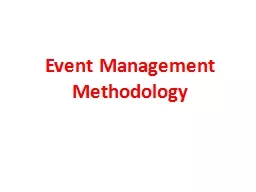

Time is a essential part of event planning Event planning is not a casual affair it need professional planning for proper planning and management of the event Time is very important Time management errors can cost a company a potential sale lose them an existing customer and damage their pro ID: 920593
Download Presentation The PPT/PDF document "Event Management Methodology" is the property of its rightful owner. Permission is granted to download and print the materials on this web site for personal, non-commercial use only, and to display it on your personal computer provided you do not modify the materials and that you retain all copyright notices contained in the materials. By downloading content from our website, you accept the terms of this agreement.
Slide1
Event Management Methodology
Slide2Time is a essential part of event planning. Event planning is not a casual affair, it need professional planning for proper planning and management of the event. Time is very important.
Time management errors can cost a company a potential sale, lose them an existing customer, and damage their professional reputation.
Time management for event planners teaches readers how to successfully manage their workload and do what matters most, when it matters most:
Slide3Analyze and prioritize tasks
Structure your workload and your day for maximum performance
Identify red-flay activities that hinder productivity
Reduces stress-producing time crunches
Identify when extra help is needed, as well as how to delegate, outsource, and even partner with suppliers in crunch periods
Work with rather than against deadlines
Save time using technology
Manage multiple projects, even in multiple time zones
Slide4Event Management Principles
Moment
of risk and state of
activity
Moment of risk and state of activity
An activity (task) in most real life processes is not a continuous uniform procedure. Tasks are affected by external events, which transform an activity from one state to another.
One of the important properties of an event is the moment when an event occurs during the course of an activity. This moment, when an event occurs, in most cases is probabilistic and can be defined using
statistical distribution
.
Event
Chains
Events can cause other events, which will create event chains. These event chains can significantly affect the course of the project. For example, requirement changes can cause an activity to be delayed. To accelerate the activity, the project manager allocates a resource from another activity, which then leads to a missed deadline. Eventually, this can lead to the failure of the project.
Monte Carlo
Simulations
Once events and event chains are defined, quantitative analysis using
Monte Carlo simulation
can be performed to quantify the cumulative effect of the events. Probabilities and effects of risks are used as input data for Monte Carlo simulation of the project
schedule. In
most real life projects, it is necessary to supplement the information regarding the uncertainties expressed as an event, with distributions related to duration, start time, cost, and other parameters.
Slide5Critical Event Chains
The single events or the event chains that have the most potential to affect the projects are the “critical events” or “critical chains of events.” By identifying critical events or critical chains of events, we can mitigate their negative effects. These critical chains of events can be identified by analyzing the correlations between the main project parameters, such as project duration or cost, and the event chains.
Performance Tracking with Event Chains
Monitoring the activity's progress ensures that updated information is used to perform the analysis. During the course of the project, the probability and time of the events can be recalculated based on actual data. The main issue with performance tracking is forecasting an activity’s duration and cost if an activity is partially completed and certain events are assigned to the activity. The simple heuristic approach to this problem is to analyze the moment of risk, which is defined as one of the event parameters. Advanced analysis can be performed using a Bayesian approach.
Event Chain Diagrams
Event Chain Diagrams are visualizations that show the relationships between events and tasks and how the events affect each other. The simplest way to represent these chains is to depict them as arrows associated with certain tasks or time intervals on the Gantt chart. Different events and event chains can be displayed using different colors. Events can be global (for all tasks in the project) and local (for a particular task). By using Event Chain Diagrams to visualize events and event chains, the modeling and analysis of risks and uncertainties can be significantly simplified. Event Chain Methodology Phenomena.
Slide6Thank You……